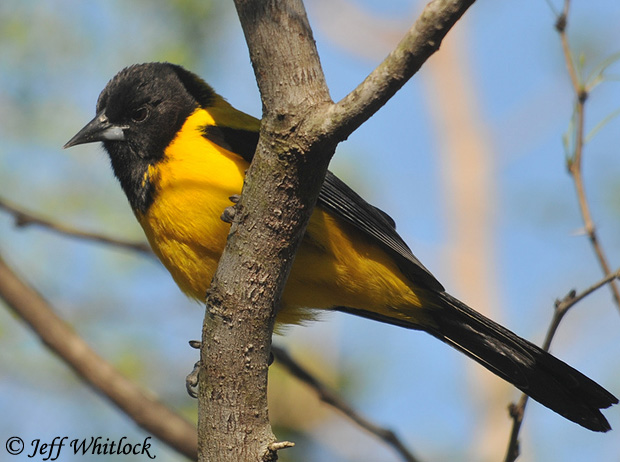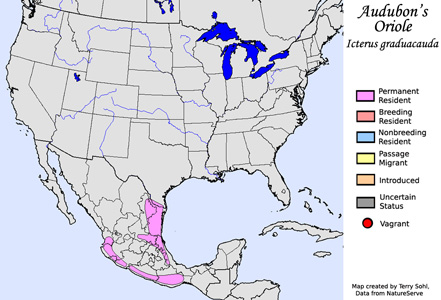| Length: 9.5 inches | Wingspan: 12 inches | Seasonality: Non-resident in South Dakota |
| ID Keys: Completely black head, orangish-yellow body, black wings with thin white wing-bar, greenish on back | ||
 The
Audubon's Oriole is primarily a bird of Mexico, with a range that just
crosses into the U.S. in far southern Texas. There, they are uncommon
and most often found in woodland forests along the Rio Grande river.
Their often secretive nature and tendency to forage in dense cover makes
them a species that is often difficult to spot.
The
Audubon's Oriole is primarily a bird of Mexico, with a range that just
crosses into the U.S. in far southern Texas. There, they are uncommon
and most often found in woodland forests along the Rio Grande river.
Their often secretive nature and tendency to forage in dense cover makes
them a species that is often difficult to spot.
Habitat: In the small U.S. portion of their range, Audubon's Orioles are most often found in woodlands along the Rio Grande river, but they can also sometimes be found in thick stands of mesquite further north. In Mexico, they are found in a variety of woodland habitats.
Diet: Feeds heavily on insects and spiders, but will also eat berries. Sometimes visits flowers to feed on nectar.
Behavior: Feeds deliberately, often in dense cover, moving through the foliage and gleaning insects. They will also sometimes forage on the ground.
Nesting: The nest of an Audubon's Oriole is a hanging cup-shaped pouch made of grasses, and often concealed fairly well within the outer branches of a small tree. The female lays between 3 and 5 eggs, and she alone incubates the eggs. After the eggs hatch, both parents help to raise the young.
Interactive eBird Map: Click to access an interactive eBird map of Audubon's Oriole sightings
Song: Song of the Audubon's Oriole is a series of low-pitched, meandering whistled phrases.
Migration: Considered a permanent resident throughout their normal range.
Similar Species: In range, most likely to be confused with Scott's Oriole.
Feeders: Will sometimes attend hummingbird feeders for sugar water.
Conservation Status: Populations of Audubon's Oriole may be in decline, but the IUCN currently lists them as a species of "Least Concern".
Further Information: 1) Cornell's All About Birds - Audubon's Oriole
2) WhatBird - Audubon's Oriole
3) Aspects of the Breeding Biology of the Audubon's Oriole
Photo Information: Photo taken by Jeff Whitlock - March 1st, 2009 - Salineno, Texas - Photo licensed under Creative Common Attribution NonCommerical ShareAlike 2.0 Generic License.
| Click below for a higher-resolution map |
 |
| South Dakota Status: Non-resident in South Dakota |
Additional Audubon's Oriole Photos (coming soon!!)
